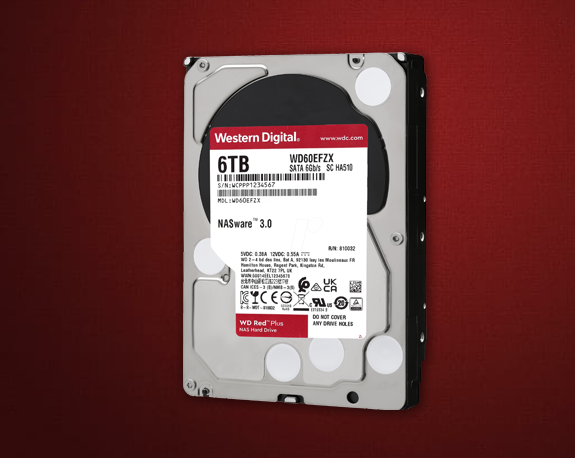Western Digital hard drives come in 2.5" and 3.5" formats. They can have the following interfaces: SATA, SAS, SCSI, IDE, FC.
Modern internal Western Digital ranges are the following: WD Purple, WD Red, WD Black, WD RE, WD SE, WD VelociRaptor, WD AV-GP WD Green, WD Caviar Blue, WD AE, WD Red PRO, WD Green, AV -25, WD Blue, WD BLACK2, WD BLACK, WD XE SAS.
Causes of data loss at Western Digital
Malfunction of the read heads – Western Digital hard drive is not recognized in the BIOS / via USB
The most common cause of failure of hard drives of this brand is a malfunction of the read/write heads. The read/write unit then does not calibrate properly, which manifests itself in regular seek movements of the read/write unit. Another cause of a malfunction can be physically defective sectors on the data medium. As a result, the data originally stored in these sectors can no longer be read. In the worst case, parts of the defective sectors are in the system area of a Western Digital hard drive, which makes access to the technical interfaces even more difficult. Due to progressive damage to the surface structure, it is often not possible to read out and process the entire database. In the event of a malfunction of the read/write heads, the data rescue is carried out using special software tools and modifications to the hard disk in a clean room laboratory environment in order to address the data carrier. If these modifications are successful, an image of the hard disk will be created in its raw physical format. The file system structures in the raw data are then checked for their usability.
Failure of one or more individual magnetic heads
In this case, data recovery is possible by modifying the hard drive firmware in technological mode. Only the user data on functional read heads is read out. Depending on the hard drive model and the extent of the damage, this method can recover between 20 and 100% of the relevant user data. However, if it is found that a substantial part of the data is missing, it is necessary to replace a block of magnetic heads and read other missing areas. Due to the constantly increasing recording density, it is often necessary to replace magnetic heads several times in order to obtain an acceptable readout rate. It also applies the process of customizing donor magnetic heads to a specific instance of a hard drive.
WD PCB Electronics Malfunction - Western Digital Hard Drive Will Not Spin Up
In the event of a PCB electronics failure, advanced diagnostics are performed on a WD hard drive assembly. The aim of this diagnosis is to find the faulty assemblies and, if possible, to repair or replace them. If a WD hard drive electronics cannot be repaired, the entire PCB will be replaced. During the diagnosis, a copy of the firmware ROM is also created and checked for completeness. The firmware consists not only of a microcode, which can be identical for the same series, but also of certain adaptives that are individually adapted to each hard disk ex works. If the adaptives are not available, they must be recalculated or adapted to the faulty hard disk. This is done by further subtracting service modules from the magnetic surface of a WD hard drive. If some components of the firmware are defective, a replacement copy will be made. The copy is then either loaded directly into the RAM memory of a WD hard drive or written into the boot ROM using an EEProm reader or via the special technical interfaces for this. However, some modern Western Digital hard drives, such as WD My Passport and WD Elements USB, do not have a separate ROM chip and store the firmware parts in a mask ROM directly in the controller of the WD hard drive. In this case, an attempt is made to repair the circuit board if possible. If the repair is not possible, a ROM image is assembled and this image is written into the mask ROM of a replacement PCB controller. Another diagnosis is then carried out and it is tested whether the sectors of the defective hard disk are read correctly.
Data recovery WD SMR hard drive
Some of Western Digital's newer SMR drives have incorporated more modern translation methods to handle Shingled Magnetic Recording (SMR). Some WD SMR mechanical hard drives support TRIM technology, which is implemented by default in Windows 7 and later. This means that formatting or initializing the device or deleting files can mean that the data is unrecoverable. However, the TRIM technology ensures that the performance and service life of SSDs or hard drives are kept at an optimal level.
WD firmware error
As a result of a partially corrupted firmware, a Western Digital hard drive hangs at startup or is very slow to access. So the drive fails even though its electronic and mechanical components are fully functional. This type of firmware error is caused by corruption due to excessive read error rate. Although firmware updates are regularly available, these updates do not fix firmware bugs. To solve the problem, a temporarily working copy of the firmware is reconstructed and loaded into the hard drive's RAM. The missing or damaged firmware parts are replaced using the firmware library. This Western Digital firmware library has been created and cataloged at our company for over 20 years.
Suction of the magnetic heads on the surface of Western Digital hard drives
Sticking to the magnetic surface of a WD hard drive usually occurs due to a sudden power failure or electronic failure. The rotation speed of the hard disk decreases and the magnetic heads do not have time to move to their parking position. In addition, sticking may occur as a result of an impact. Due to the reduction in airflow, the magnetic head approaches the surface of the hard drive. Because both the surface of the disk and that of the magnetic heads are perfectly smooth, the reading heads are sucked onto the surface of the hard disk. When the drive is turned on afterwards, they don't allow the hard drive to continue spinning freely. Various methods and special tools are used to remove the reading heads from the surface of the disks. In most cases, an unreadable sector area forms on the contact surface. In modern hard drives, a few heads often fail as well. After the heads are removed from the surface of the disks, their condition is checked under the microscope. If they are in good condition, data recovery can be performed in technological mode with constant process control. In the event of a misalignment of the magnetic heads, the process control guarantees that the rotation of the disk surface is automatically stopped and the magnetic heads are immediately guided to their parking position. This procedure is specified for WD hard drives, but can also be used for hard drives from other manufacturers.
Data recovery from external Western Digital hard drives
A disadvantage for data recovery from modern external WD 2.5'' drives of the WD My Passport and WD Elements series is the USB interface integrated into the electronics. This interface prevents direct access to the ATA interface of the hard disk. Strictly speaking, it does not allow sending ATA commands to the hard disk and working with hard disks with hardware errors in the special technological mode. In addition, the data is usually encrypted by the hard disk controller. Thus, the user-friendly USB interface is rather unfavorable for data recovery work. As part of data recovery from Western Digital USB hard drives, a SATA interface is therefore temporarily integrated into a USB hard drive.
The following series are known among external Western Digital hard drives:
- WD my Passport 2.5'' form factor.
- WD Elements 2.5'' and 3.5'' form factor.
- WD My Book 3.5'' form factor.
Our success rate for Western Digital hard drive data recovery is over 94%.
Data recovery process
Be vigilant and do not attempt to salvage the data on the device yourself. This can make recovery impossible.
Data recovery from storage media from other manufacturers
All orders are processed exclusively in our Berlin laboratory. The data recovery from mechanically defective hard drives takes place within a dust-free environment of our clean room workbench of clean room class 100.










